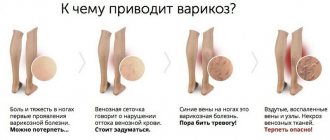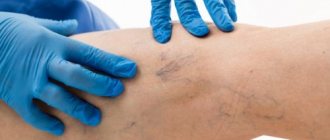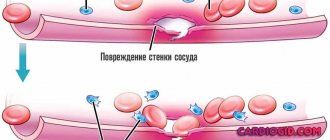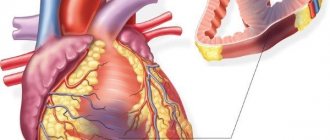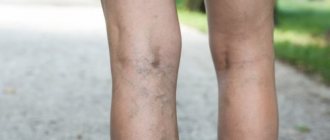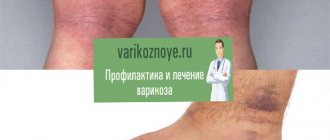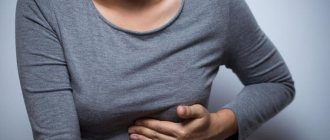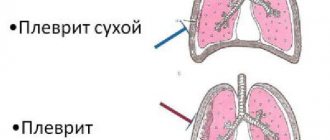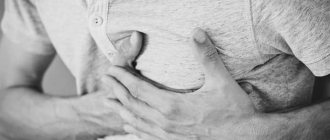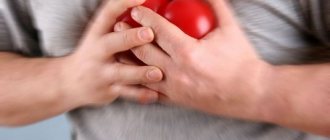Should I worry?
A hematoma is a dense clot that is located in the cells of the skin. It is formed due to injury to a vein or artery and the leakage of blood into nearby tissues. Fragility and weakness of blood vessels are caused by various factors.
Without treatment, the pathology can develop into a severe and long-lasting illness. Therefore, when you first detect alarming signals, you should immediately visit a specialist, undergo a full medical examination and begin treatment on time.
The mechanism of bruising
Without receiving a blow, bruises on the leg occur due to ruptures of the vascular walls and blood flowing beyond them.
Bruises are identified:
- Hematoma. They form under the skin, deep in the muscle tissue. The affected area hurts a lot.
- Vasculitic purpurea. They are inflammatory in nature, accompanied by itching and rashes.
- Microcirculatory. They are located on the upper and lower extremities and mucous membranes. They occur after heavy blood loss, even with minor exposure to the skin.
- Microcirculatory-hematoma. They are large in size and have a mixed form).
Causes of bruises on legs
The presence of bruises that appear on the body for no apparent reason may indicate that a person has diseases of the internal organs. Among them:
- dysfunction of the endocrine system;
- disturbances in blood circulation and cardiovascular activity;
- varicose veins of the legs;
- problems with immunity (lupus erythematosus);
- thrombosis;
- pathologies of the liver, kidneys, urinary tract;
- arterial hypertension;
- rheumatism;
- vasopathy (intoxication of the body);
- hemorrhagic vasculitis;
- breast cancer in women;
- oncological diseases;
- damage to the brain and central nervous system;
- subcutaneous hemangioma;
- age-related changes associated with natural cell aging.
In children, factors in the development of pathology can also be:
- improperly organized daily routine;
- low mobility;
- worms;
- unbalanced diet;
- weakness of blood vessels;
- thyroid problems;
- past infections;
- incorrectly administered injection (use of a short needle, accelerated rate of drug administration, development of muscle spasms, allergies).
In children, the anomaly is often accompanied by:
- increased body temperature;
- disturbance of speech and motor activity;
- short-term decrease in vision;
- drowsiness, lethargy;
- dizziness;
- prolonged and frequent bleeding from the nose and mouth.
Hypovitaminosis
A lack of vitamins (C and P), minerals (zinc, iron, selenium, cobalt) can also provoke the disease. A deficiency of components necessary for health leads to a decrease in the strength and elasticity of cell membranes, which is associated with a lack of collagen. As a result, ruptures and destruction of the venous walls occur.
Thrombocytopenia
A decrease in the number of platelets leads to poor blood clotting, resulting in spontaneous bruising.
Phlebeurysm
The appearance of bruises on the veins of the legs is due to the fragility of the superficial vessels.
Menopause
One of the possible reasons explaining why bruises appear on women's legs. The absence of menstruation is associated with a decrease in the level of the sex hormone estrogen in the blood. Occurs during hormonal changes in the body.
Leukemia
Characterized by damage to the bone marrow and blood. Among the main symptoms:
- overwork, lack of air;
- active formation of bruises and hematomas;
- bleeding of internal and external organs, mucous membranes;
- swollen gums;
- discomfort in the stomach;
- increased body temperature;
- excessive sweating (especially noticeable at night);
- headaches, painful sensations in the bones;
- swollen lymph nodes;
- skin rashes;
- weakened immunity, frequent susceptibility to infections.
Bruises after training: causes
The appearance of bruises after childbirth and during pregnancy will not surprise anyone, since there is a natural explanation for this - during pregnancy, certain changes occur in a woman’s body, the consequences of which manifest themselves after childbirth. The appearance of hematomas in an interesting position and after the birth of a child can occur due to:
- thrombophilic disorders
- hemorrhagic diathesis
- varicose veins
- taking medications
- vitamin deficiency
- liver diseases
Bruises can occur for no reason during pregnancy
To prevent bruises on your legs, take a contrast shower, but be very careful not to get sick. After all, you now have to worry not only about your health, but also about the health of your baby.
Sport is very important, both for overall well-being and for the formation of a beautiful figure. But there are situations when bruises appear on the body after training, the reason for this may be:
- Bruises during training – the simplest explanation for bruises is a bruise during training. You can hit the apparatus or, if this is a doubles sport, from a partner
- Fragile vessels - this option also cannot be ruled out; from heavy loads or active training, vessels can burst, which leads to hemorrhages, and as a result, bruising
- Poor nutrition – if you work out hard, you definitely need to eat right. During training, you lose a lot of energy, which must be restored, otherwise fragile blood vessels and a weakened body will be the result of your training
Bruises may occur during intense training.
Take care of your body and body, but do not overwork or exercise to the point of exhaustion, otherwise the consequences may not be the best.
Localization
The location of the bruises depends on the underlying cause that caused them. The disease can manifest itself not only on the lower extremities, but throughout the body.
Most often, bruises occur on the legs (thighs, calves, legs, ankles) due to varicose veins and vascular problems. They are accompanied by general fatigue, swelling, and the formation of a subcutaneous vascular network visible through the light.
Diagnosis of hemorrhagic vasculitis determines the formation of bruises in the form of blood-red spots on the elbows and knees, buttocks, face, feet, and palms. Small pathological dots can merge with each other into a single whole.
Bruises caused by hemophilia are located on different parts of the body. They can be caused by any, even the most minor, bruises or injuries.
Erythremia (increased levels of red blood cells in the blood) is characterized by hematomas on the lower extremities, which are complemented by pain in the heart, arterial hypertension, and physical exhaustion.
Bruises in women after childbirth
Women who are in the postpartum period often experience bruises on their legs. This is due to varicose veins, which develop due to the fact that during pregnancy the blood vessels are exposed to increased pressure, the load on them increases, they become thin, lose strength and elasticity, vitamin deficiency and hormone imbalance are observed.
To cope with hematomas, it is recommended:
- apply cold to the problem area;
- lubricate the lesion with an ointment containing vitamin K;
- organize a proper diet.
Bruises under the eyes
Bruises under the eyes indicate:
- chronic infections;
- diseases of internal organs (dysfunction of the kidneys and liver, cardiovascular and respiratory systems);
- improper lifestyle, bad habits;
- long periods of work at the computer;
- eye diseases;
- lack of nutrition, sleep and rest.
To establish the true cause of the anomaly, a full medical examination is necessary.
The veins in the legs and arms are swollen, what should I do?
When you noticed that a vein in your leg was swollen, what was the first thing you thought? This is unsightly and spoils the appearance of your legs or arms. This approach is especially typical for women. But is this how you should react to such a manifestation? Absolutely not!
Bloating veins are a serious condition called varicose veins. Unfortunately, it is irreversible and requires treatment at any stage. It's good if you notice the swollen area at the very beginning of the process. You can get by with conservative therapy. In the case of an advanced process, surgical intervention is inevitable.
Why do veins swell?
The problem of swollen veins in the legs and arms can affect almost every person. Today, every third woman and every fifth man on the planet suffers from varicose veins.
But common factors include the following:
- Heredity. If someone in your family has had a similar problem, you need to be extremely careful, take preventive measures, and even a slightly swollen area should force you to immediately consult a doctor.
- Uncomfortable shoes or clothing. This is especially true for women, because the most critical factor that causes swollen feet will be heels. Also tight shoes and clothing that tightens blood vessels.
- Staying in one position for a long time - sitting or standing. This applies to professional activities.
- Heavy physical activity, violation of the rules of lifting weights. Swollen veins in the arms are a consequence of such actions.
- Playing sports with high intensity. This applies to professional athletes and amateur fans who do not know the limits and neglect the advice of experienced instructors.
- In women, pregnancy “helps” veins to swell, when the load on the lower limbs increases significantly.
The next series of reasons is more relevant to men who experience varicose veins.
But modern women are not inferior to the representatives of the stronger sex, so again, everything is relative:
- regularly lifting and moving heavy objects;
- bad habits: smoking, drinking alcohol;
- a sedentary lifestyle (physical inactivity) and, as a result, an increase in body weight above the norm;
- the position of the legs in a sitting position is cross-legged (this applies to both sexes);
- unhealthy diet, which consists of fast food, fried and spicy foods with an abundance of preservatives and food additives;
- age is a factor that a person, unfortunately, has no influence on.
Forewarned is forearmed. It is useful to find out about possible causes in advance and try to avoid them. And if the disease already exists, then you can only regret your mistakes. And, of course, choose adequate treatment.
Symptoms of the disease
The first signs will be:
- constant feeling of tiredness in the legs;
- the limb in the area of the calf muscle “bursts”;
- a feeling of pain and burning appears, which worsens in the evening;
- legs become heavy and swollen;
- Cramps often appear, especially at night.
If the veins in your legs are swollen, you need to choose the right treatment. And for this you need to know what stage of the disease is present.
Stage zero (0), as a rule, occurs without external signs and diagnostics do not give any results. Although the vein can swell somewhere inside the thickness of the skin and signal very weakly. But treatment must already be started in order to prevent the next stages of the disease.
The following stages of the disease are distinguished:
- Stage 1 is characterized by changes in the form of spider veins of different sizes.
- At stage 2, dilated veins appear, which can be visible through the thickness of the skin or rise slightly above the surface.
- Stage 3 has pronounced swelling of a limb (or two at once), depending on the course of the process.
- At stage 4, skin manifestations in the form of eczema plaques and dermatitis may appear.
- At stage 5, trophic ulcers appear on the skin.
- At stage 6, the deep veins are involved in the process. It is with this clinical picture that venous breakthroughs and heavy venous bleeding are possible.
Treatment options
What to do if the veins in the leg swell, a phlebologist who treats this type of pathology will tell you. In his arsenal there are many conservative treatment methods that will help relieve inflammation, stop the process and improve the quality of life. The usual treatment protocol for varicose veins is quite simple.
We will consider only measures at the initial stage of the disease, since all others require regular monitoring by a specialist:
- Oral medications that help maintain and restore blood vessels in the legs.
- Ointments, creams and gels that act locally are applied several (at least 2) times a day and help fight the symptoms of varicose veins.
Our readers successfully use ReCardio to treat hypertension. Seeing how popular this product is, we decided to bring it to your attention. Read more here...
- Review of diet. It is necessary to completely eliminate foods that contribute to the accumulation of cholesterol and cause weight gain. This way you will avoid the formation of blood clots and reduce the load on your legs.
- Compression garments are prescribed directly by the doctor, taking into account all the indicators of your body.
- Exercise therapy must be present, swimming is especially welcome. But physical activity should be strictly dosed, moderate, with selected loads.
Prevention
In order not to resort to the help of specialists in various fields of medicine, and not just a phlebologist, for a long time, you need to follow a few simple rules, and then your life will be long and happy.
When it comes to nutrition, remember these rules:
- Spicy, fatty fried foods provoke the accumulation of cholesterol in the vessels, which is fraught not only with varicose veins, but also with cardiovascular problems.
- Carbonated drinks, foods with food additives, preservatives and flavor enhancers - all these food chemicals act as poison for the body's cells, clogging blood vessels throughout the body.
- You need to include a lot of fresh fruits and vegetables, cereals and whole grain bread in your diet. Many vitamins and microelements that are beneficial for all organs and systems are contained in natural vegetable fats - olive oil and its other relatives.
- Seafood contains essential amino acids that contribute to the restoration of organs and tissues and their proper functioning.
Taking care of your feet and hands:
- It is necessary to avoid lifting heavy objects - the first cause of bulging veins in the extremities.
- When sitting in one place for a long time, you need to take a break every 2-3 hours, get up and stretch your legs, do light exercises, or at least walk around in place.
- If you are on your feet for a long time, also take breaks every 2-3 hours - sit down for 15-20 minutes. And raise your legs above your pelvis.
- Frequent visits to baths and saunas are not recommended. Excessive tanning or visiting a solarium is also harmful.
Hardening and strengthening:
- Recently, yoga and massage using Tibetan techniques have become very fashionable.
- At home, you can massage your feet, calves and thighs yourself to improve blood circulation in your extremities.
- A contrast shower will not only strengthen blood vessels, but also improve the general condition of the body.
Choose for yourself what is better – treatment or prevention. However, a swollen vein in a leg or arm should be a cause for concern and at least a review of your lifestyle.
A visit to a specialist can save you from a hospital bed, surgery, or even disability.
>
Diagnosis of the causes of bruises on the legs
The diagnosis is made by:
- blood tests;
- radiography (if there are limb injuries);
- ultrasound examination of blood vessels;
- visual examination by a doctor.
Additionally, an examination of the whole body may be necessary to determine diseases of the internal organs.
Diagnostic features
Why does it itch at the site of the bruise? This question concerns many people who have ever been injured or hit. Many people believe that this may be the result of dangerous illnesses and disorders, but this is not the case. Itching indicates an active recovery process.
It is worth noting! If the bruise itches and itching does not appear on other parts of the body, then there is no need to worry. The discomfort will disappear on its own after the injured tissues heal.
But at the appointment, the doctor should ask about the patient’s condition, the nature of the itching and the time when it appeared. If you start itching before the bruise appears, then an examination will be prescribed that will help determine the disease that caused these suspicious signs.
The following examinations may be performed during diagnosis:
- laboratory blood tests;
- general blood test for sugar levels;
- additional instrumental studies. They are performed to accurately determine changes in the functioning of internal organs.
What treatment is needed
Therapy for the disease is also determined by the causes of its occurrence.
Who to contact?
If bruises regularly or periodically appear on your legs for no reason and are not associated with mechanical injuries, then you should initially seek help from a therapist or vascular surgeon (phlebologist). Depending on the results of the diagnostics performed, a treatment regimen is determined. You may also need to consult other specialists (endocrinologist, oncologist).
Treatment and prognosis
Bruises on the legs do not occur without a reason. After a complete diagnosis, the specialist determines the provoking factor and selects a treatment regimen to eliminate it.
Different doctors treat patients with similar pathologies. If a patient complains of bruises on the heels for no reason, then perhaps the cause is still wearing the wrong shoes, so such patients are treated by an orthopedic doctor. Patients with leukemia are treated by an oncologist, and women during menopause are treated by a gynecologist. However, regardless of the nature of the disease, the formation of hematomas requires consultation with a vascular surgeon or phlebologist.
For hypovitaminosis
Constantly appearing bruises caused by hypovitaminosis suggest treatment by taking the missing vitamins. To strengthen blood vessels, ascorbic acid and Ascorutin are prescribed. Additionally, a complex of vitamins and the introduction of foods containing vitamin P and C into the diet are recommended.
For thrombocytopenia
If thrombocytopenia develops as a consequence of taking the drug, the drug is discontinued. Hematomas that appear on the thighs, lower legs and other parts of the lower extremities disappear completely only after 2 to 3 weeks. If the disease is caused by other reasons, then treatment is more complex and lengthy.
Note! Thrombocytopenia, as a symptom of another disease (eg, HIV), may require lifelong therapeutic treatment.
For varicose veins
Small bruises on the calves and thighs occur with varicose veins. Treatment of vascular disease is carried out therapeutically, but in severe cases, when blood clots form, and instead of small bruises, dark blue hematomas with protrusion of veins are formed, surgical intervention is required.
During menopause
During menopause, hormone replacement therapy is recommended to restore the level of the hormone estrogen. Additionally, they take vitamins, and also use traditional methods that strengthen women's health.
For leukemia
Treatment of such a dangerous disease as leukemia takes a long time. The prognosis for patients is not always favorable. Without surgical intervention, only supportive therapy is carried out. Chances for recovery arise only after a bone marrow transplant operation.
Symptomatic treatment of a bruise
During the main treatment period, symptomatic therapy is carried out, the purpose of which is to restore the strength of blood vessels, accelerate cell regeneration and eliminate the consequences of hemorrhage.
For hematomas, medications are used:
- Heparin ointment;
- Indovazin;
- Troxevasin;
- ointments with arnica.
Such drugs help get rid of bruises on the knees, calves, thighs and other parts of the legs.
Important! Ointments for resorption of hematomas may be contraindicated if the blood clotting process is impaired. Before use, be sure to consult with your doctor.
Folk remedies for bruises
They are highly effective, often used to eliminate unpleasant symptoms, but have a local effect without affecting the true cause of the disease.
In case of pathology it is recommended:
- apply a cabbage leaf to the sore spot (chopped plant matter mixed with honey, alcohol or vodka has a faster healing effect);
- make a compress from grated potatoes (a positive effect is observed after three to four days).
If a bruise occurs on the knee or other part of the leg, do not treat the area with iodine: this will increase the bleeding.
How to prevent bruises on your legs?
To protect yourself as much as possible and prevent the formation of subcutaneous hematomas, we advise:
- Strengthen the body with vitamins, eat healthy and wholesome food: apricots, citrus fruits, carrots, kiwi must be included in the diet.
- Practice contrast showers or baths: procedures strengthen the walls of blood vessels, making them stronger and more elastic.
- Use ointments with vitamin K.
- Use medications “Bromelain” (breaks down protein), “Arnica” (prevents bruising).
All medications should be taken only as prescribed by your doctor.
- Lead a healthy lifestyle.
- Go in for sports, perform a set of physical exercises daily, evenly distribute the load on the limbs.
Bruises for no reason in men
If bruises appear on your body, but you do not know their obvious cause, then consider the most likely causes, not taking into account bruises from blows or bruises:
- In the case of blood diseases, this may be related to the platelet count. Be sure to undergo a thorough examination and blood test
- Vessels are located close to the skin
- Vitamin deficiency
- Taking medications that thin the blood or cause fragility of blood vessels
- Initial degree of manifestation of varicose veins
- Disruption of the nervous or endocrine system
Bruise in a man
You should not be negligent about your health; undergo a thorough examination if you observe symptoms such as the appearance of bruises for no reason. All causes, except the proximity of blood vessels, are subject to drug treatment.
Complications with bruises on the legs
If bruises on your legs occur for no reason and constantly, you should definitely seek advice from a specialist. Otherwise, the anomaly is fraught with the formation of a voluminous dense lump under the skin, which is caused by intense and prolonged leakage of blood from the damaged vessel.
Bruises on the legs are not an independent disease. Often they act as an alarming signal that not everything is in order in the body, and it requires increased attention to itself. Timely seeking qualified help will help eliminate the source of the disease and relieve unpleasant symptoms for a long time.
Treatment methods
The treatment regimen for bruises on the legs is correlated with the root cause:
- subjective triggers can be easily corrected: selection of comfortable shoes, clothes, caution when moving, physical activity; if bruises continue to appear despite all precautions taken, you should visit a doctor, since the cause may be far-fetched, not subjective, but pathological;
- vasculitis - treated by prescribing a course of antibiotic therapy, and in case of non-infectious etiology - NSAIDs, hormones, cytostatics;
- thrombocytopathies are treated with hemostatic agents, glucocorticoids such as Prednisolone;
- congenital defects of the vascular wall cannot be corrected in principle;
- thrombocytopenia is correlated with the number of platelets and is treated by taking hemostatic agents, blood or plasma transfusions, blood substitutes to restore the total volume of circulating blood, clotting factors;
- metabolic disorders, vitamin deficiency are corrected by artificial introduction of missing substances into the body, diet, balanced diet, purpura is corrected by the abolition of drugs that provoke fragility of blood vessels;
- if the reason is poor absorption of nutrients, it is necessary to treat the root cause of the pathology in the duodenum and small intestine;
- symptoms of diabetes mellitus are eliminated with hypoglycemic drugs and diet;
- atherosclerosis is treated with statins (Rosuvastatin, Atorvastatin) and a balanced atherogenic diet;
It is important to normalize your daily routine, give up bad habits, avoid stress, and eliminate physical inactivity in favor of reasonable physical activity.
